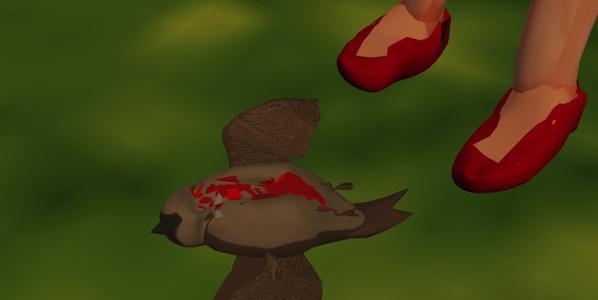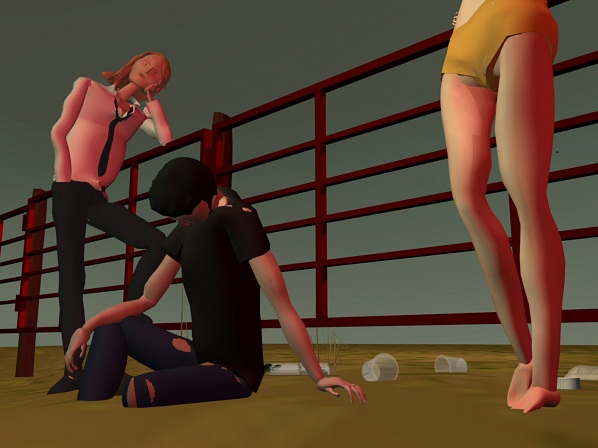



James Lowne won the Animate Digitalis Prize in 2011, with his computer animation Someone Behind the Door Knocks at Regular Intervals. His latest animation, Our Relationships Will Become Radiant (2012) was recently screened at the BFI and Tate Modern, and is now available on DVD.
Sarah Thompson: First let’s talk about Someone Behind the Door Knocks at Irregular Intervals. How did you go about creating this piece?
James Lowne: Something that interested me was the idea of contemplation and distraction, how we relate to these contrasts in a space where images are in circulation. The production of gestures and poses that are prepared, cropped and then framed for output as media content. So for this film I tried to convey these themes, within a cinematic sense, by way of a narrative. A friend gave me a piece of music and I thought I would set down some pictures to this. I began to source pictures from different places, personal photographs, movie stills, magazine ads, and consider new arrangements of these, treating them as objects. For me this appropriation is an important part of the process.
ST: Appropriation of data objects?
JL: Images could be seen as condensed information perhaps, but what I find interesting is the effect of accumulation, like interchangeable tiles. A grand narrative of the exchange, and this is what becomes more important than the singular image. But conversely, and what I find incredible, is that always within the homogeneous there is this latent singular moment, where one image, an instance of infinite copies, presents itself as unique in a particular situation to a particular viewer. The image selects the viewer, not the other way around.
ST: It has the particular quality of exploring psychic space, which I think is a key quality of Computer Animation. Do you think this is why the medium suits you so well?
JL: Well, I think we should elaborate on the term psychic space. And also think about what we mean by computer animation. What is the working process? What is the form of presentation? Still it is being used within the parameters of filmmaking. Mainstream cinema CGI relies heavily on anthropomorphism, a long line of tradition from early cell animations. To move an object suggests giving it life of some kind, but the process of making the image move is different now, it’s much quicker for one. What the computer brings to the animator is the illusion of a 3 dimensional environment as a working space, the monitor resembling the camera frame. What interests me is the ability to very quickly explore what effects a camera can have over a subject and how the subject has been posed. Capturing gestures from different angles and rendering them into images brings the meaning of this body language into question. The computer can allow you to make these decisions at incredible speeds, whizzing the camera around the subject with your mouse and keyboard. You couldn’t do this so quickly with actual cameras and so a new selection process comes into play, and this for me suggests the relationship of space and surface, and you can work like a machine, running through infinite choices.
ST: So the relationship is perhaps more of a spatial one?
JL: Yes, but a simulated space. The computer allows us to enter into this space and this is with the use of an interface, and this is the fundamental difference from, say, drawing on paper, or painting.

ST: The characters in both films are ‘roughly drawn’ as though you were ‘feeling the way’ as you were making it. Is that so?
JL: Drawing and writing form a starting point for my work, and I am more interested in ideas. I didn’t have a camera or any actors, but I did have a computer. I had learnt how to use all these graphic software programmes from the commercial work I had done. It struck me that the software packages end up monopolising aesthetics somewhat, with a focus on simulating cinematic styles, animating figures in a certain way, and so on. To me this seemed rather pointless and I wanted to try and get a different connection with the machine, to see if I could apply drawing through the interface. I found it very tricky, really.
ST: But through this process you make acutely emotive characters. What sort of commercial work did you make?
JL: The commercial work I had done would involve applying motion graphics onto things, or manipulating footage in post-production. I would go through frame by frame watching the actors or models in corporate adverts and film trailers. Their stylised expressions and poses I really liked, you get to think about them differently when watching them over again, and freezing on a frame of your choice.
ST: Maybe this is why these works are both funny as well as saddening. There is also a strong filmic influence like Psycho, and Blood of a Poet…
JL: For me cinema is a greater influence than animation. I like the way film can generate mood as well as story, and often the techniques of production can overwhelm the overall form. This is what is great about the old, Italian horror films of Fulci or Argento, which have relatively low production values and often, dubious narrative coherence. But this is what is so empty and distancing about them, this form makes them incredible. And the fact that I would watch them on VHS copies of variable quality only amped up the level of horror. I think these old horror films straddle that feeling of humour and terror.
ST: Like Antonioni except horror?
JL: I am not familiar with the work of Antonioni. I know Blowup, and I want to see Red Desert. But I wouldn’t make a connection with him and someone like Fulci though, that’s a whole different ball game. Fulci’s lack of filmmaking skills is the wonderful aesthetic I think, rather than the other way around.
ST: It also has qualities of traditional animation, like leaves quivering in the breeze…
JL: Yes, I like that scene as a cut away. I like the fact that in films you can uses images and sounds of nature to set certain romantic moods. I was interested in the affect that the computer generation of this style would achieve. Is it the same? The leaves look like they are kind of flashing.
ST: The narrative is all implied; do you think this puts the emphasis on the psyche of the central character?
JL: Well, I was learning about cinematic techniques as I was making the film, trying things out. Editing a sequence is very interesting to me, the way subjectivity can be manufactured by putting things next to each other. I think we tend to think about films, web and TV in a natural way when looking at media content – that this is the correct way to order a sequence of images together to tell a story – but for me this is a problem and it lends itself to playing on emotions, and this is also how we are marketed to. Is narrative implied in the dialogue between the object of advertising and the subject of consumer? In the capitalist society we are put into a space to engage with the object of choice, we shift through many surfaces of appearances quickly to construct a reality. Maybe we should edit more films like this, reflect back the illusion and test out new durations. I love the way Warhol’s films have impossible durations, making us consider ourselves rather than the work.

ST: We are very used to, if not inculcated in commercial object relations?
JL: I think Baudrillard uses the term absolute advertising, the form itself of advertising as an operational mode. He also speaks of the demand for advertising. I find it interesting in that we may try to determine our positions in the social sphere within this backdrop, even as we disregard it as meaningless, it has a role in mapping the coordinates in which media moves about.
ST: Do you think we see computer animation in a prejudicial way, and expect certain things from it?
JL: I think people expect certain styles and genres from their cinematic entertainment. I think we look for authenticity in things. We see computer animation everyday and don’t question it, for example on TV commercials, idents for the web, branding and corporate logos. Computer games are having an effect on cinema too. I think only if the context is changed people may question it.
ST: I mean that it’s possible to do things and say things with animation which wouldn’t be so realisable with film, animation is maybe more iconic?
JL: I think film and computing are very much as one now. Anything can be achieved in a post-production suite, and is quite often expected of film today. I think the aesthetics should cross even more rather than CGI trying to emulate film. The opening scene to David Lynchs’ Mulholland Drive for me is a perfect way of using computer graphics and film, and this achieves an amazing effect for the cinema.
ST: In Our Relationships Will Become Radiant there is a similar exploration of the psychic space between individuals to Someone Behind the Door but it is drawn out further and even more oblique. The characters have a special relationship with images in a frame? Like i-Pads almost. They find the ‘photographs’ lying on the ground.
JL: Well, I was trying to use narrative to look at subjects, to look at relationships within a network of some kind. I wanted to let the film generate some of its own relationships. In the narrative there is this kind of defined physical space that these people find themselves in, although they try to make this space limitless. I was interested in the idea that they lose their physicality somewhat, maybe disregarding their bodies, or appropriating themselves as images.
ST: Perhaps the specifics of the narrative ‘don’t matter’, it is as though you are finding the essence of manners of relating which can be more subtle in CG because you can manipulate the models more quickly?
JL: Certain narrative forms we take for granted as real, news reports or some big corporate event, the way these things are mediated to us we accept as a truth, the way that it actually is or actually happened, which is obviously not true. I think narrative forms should be explored to allow us to think about what we take for granted as truth, and even further, how do we act in the space of choice between different truths when the mediation of these subjects is the same?
ST: Is it that a narrative can be suggested, but it doesn’t actually have to be a narrative to have a narrational effect? And then it is sort of how we find meaning symbolically in pictures, and that helps us to make sense of life?
JL: Well, exactly. Questioning things is very important, especially if we are to live in a network of images. In conventional narrative forms emotion and passion can be exploited very easily, and maybe this helps keep those accepted forms of mediation in operation. Cinematic narratives can be reframed in new stylistic approaches to adapt to the present ideology, but are we breaking away from the conventional structures?
The DVD is available from the BFI shop, published by Filmarmalade, and it also includes a second new film, Corporate Glossy Warhol Burger, co directed with Gordon Shrigley